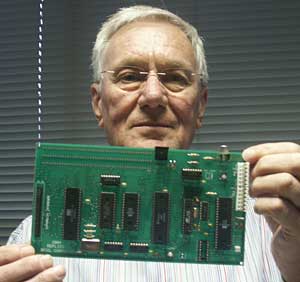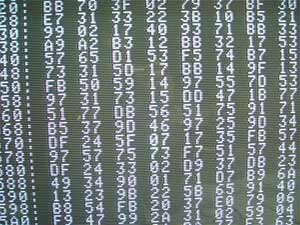iMug Meeting Notes—March 2006
Celebrating Apple Computer's 30th Anniversary—
A look back at the Apple I
Celebrating the 30th anniversary of the formation of Apple Computer Inc was the focus of the March 2006 iMug monthly meeting. Electronic engineer Brian Livingston showcased an Apple I computer which he and his son Campbell Livingston built from a replica kit.
The audience was taken back to the computing and programming world of 1976. The beginnings of the Personal Computer Revolution can be traced to the electronic homekits of that period.
Brian explained that computers use the binary numbering system in which there are only 0s and 1s. For example:
binary 0 = decimal 0
binary 1 = decimal 1
binary 10 = decimal 2
binary 11 = decimal 3
But binary numbers are hard to read, so they get converted to hexadecimal numbers, to display on the screen and make them easier to read. And hexadecimal numbers can get converted back again to binary numbers as instructions to do things.
This number system uses base 16. The sequence of numbers is:
0 1 2 3 4 5 6 7 8 9 A B C D E F,
where A =10, B = 11 ... F = 15.
Brian described the program he was creating to print out all ASCII characters. He drew a flow chart and then wrote the Assembly Language and the hex machine code that was loaded into the Apple I replica computer and executed.
The program ran a loop that printed out all the ASCII characters on the screen.
It worked!
For further basic information on programming and computer functions you may wish to work your way through Brian's Computer Lessons.
Apple I computers are extremely rare. One can be found in the entry hall of Apple's headquarters in Cupertino, California, whilst another can be found at the Powerhouse Museum, Sydney. The Apple I replica demonstrated at the iMug meeting will now become part of the computer holdings of Museum Victoria.
Brian prepared four tutorials for participants to read prior to his presentation so that they could become acquainted with the basics of computer programming. The topics covered were:
- All computer data is a ONE or a ZERO
- Entering and displaying memory data, the hexadecimal number system and ASCII code
- The basic computer cycle of operation
- The control and processing unit (CPU)
He also prepared a summary of his talk.
![]() Download
the four preparatory tutorials & summary of the presentation (122k
pdf)
Download
the four preparatory tutorials & summary of the presentation (122k
pdf)

Brian Livingston with the Apple I replica
that he and his son built from a kit

Display of Brian's lines of code in hexadecimal numbers

It worked!! Result of the executed instructions as shown
on the TV monitor connected to the Apple I replica
 internet macintosh user group!
internet macintosh user group!